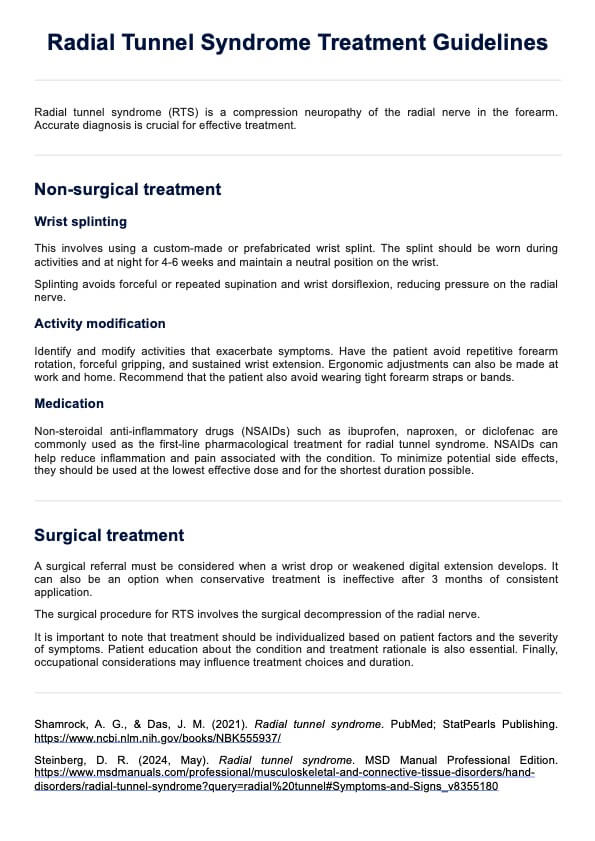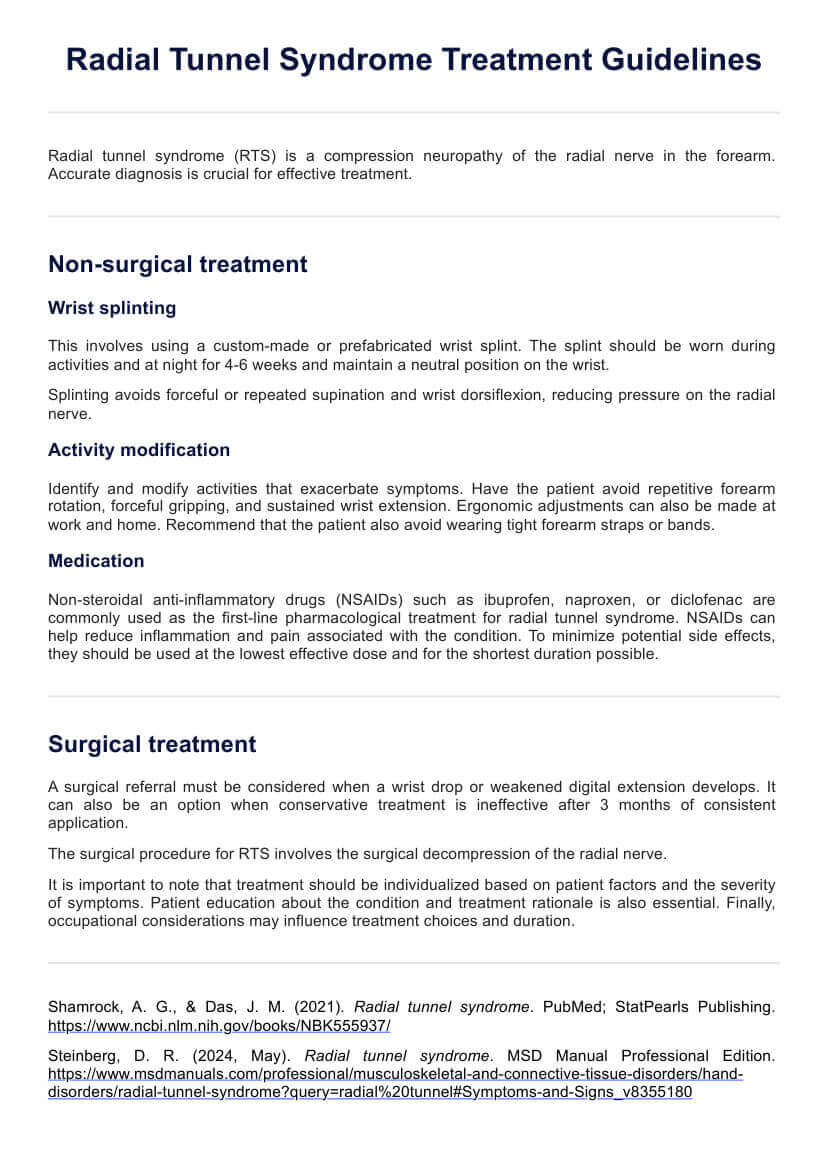Radial Tunnel Syndrome Treatment Guidelines
Access a free Radial Tunnel Syndrom Treatment Guidelines handout that can serve as an educational resource or clinical reference.


What is radial tunnel syndrome?
Radial tunnel syndrome (RTS) is a compressive neuropathy affecting the radial nerve as it courses through the proximal forearm. This condition occurs when the deep branch of the radial nerve, also known as the posterior interosseous nerve (PIN), experiences compression or irritation within the radial tunnel (Moradi et al., 2015).
The radial tunnel extends from the radiocapitellar joint to the distal edge of the supinator muscle. Common radial nerve compression sites include fibrous bands anterior to the radial head, the radial recurrent artery, and the proximal edge of the extensor carpi radialis brevis muscle.
Patients typically present with proximal forearm pain, which may radiate to the dorsal forearm or lateral elbow. This is why it might also be misdiagnosed with concerns in the lateral epicondyle. Radial tunnel syndrome can be confused with tennis elbow due to similar symptoms, such as pain in the forearm and weakness, emphasizing the importance of accurate diagnosis. However, unlike lateral epicondylitis, RTS pain is often more diffuse and can worsen with activities involving repetitive forearm pronation and wrist flexion (Naam & Nemani, 2012).
Carpal tunnel syndrome, the most common neuropathy, can be compared with radial tunnel syndrome. However, while carpal tunnel syndrome primarily causes numbness and tingling in the hand, radial tunnel syndrome is rare and presents with more diffuse forearm pain.
Key symptoms include:
- Localized tenderness over the radial tunnel
- Pain exacerbated by resisted middle finger extension
- Potential muscle weakness in severe cases
Recognizing these symptoms is crucial for accurate diagnosis and effective treatment planning of superficial radial nerve compression.
Radial Tunnel Syndrome Treatment Guidelines Template
Radial Tunnel Syndrome Treatment Guidelines Example
How to treat radial tunnel syndrome
Diagnosing radial tunnel syndrome accurately is crucial before starting any treatment. Following this, treatment typically follows a stepped approach, beginning with conservative measures and progressing to surgical intervention if necessary. Here’s an overview of treatment options:
Wrist splinting
Wrist splinting can be an effective initial treatment for RTS (Steinberg, 2024). A neutral wrist splint worn at night and during aggravating activities helps reduce pressure on the radial nerve by limiting wrist flexion and forearm pronation. It's important to ensure proper fit and educate patients on correct usage to maximize the benefits.
Activity modification
Modifying activities that can worsen symptoms is crucial in managing RTS (Shamrock & Das, 2021). This may include:
- Avoiding repetitive wrist flexion and forearm pronation
- Ergonomic adjustments at work or during daily activities
- Incorporating regular breaks during tasks that strain the forearm
Medication
Non-steroidal anti-inflammatory drugs (NSAIDs) can help manage pain and inflammation associated with RTS. Depending on the severity of symptoms and patient preferences, oral NSAIDs or topical formulations may be prescribed.
Surgical treatment
Surgical intervention may be necessary if conservative treatments fail to provide adequate relief after 3-6 months. The primary approach for RTS is the surgical decompression of the radial nerve (Steinberg, 2024). This can be performed through open or endoscopic techniques.
How to use our treatment guidelines handout template
This handout is designed to support healthcare practitioners in effectively managing patients with radial tunnel syndrome. Here's a step-by-step guide on how to incorporate this resource into your practice:
Review and familiarize
Thoroughly review the handout to understand the key points of RTS diagnosis and treatment options. This will help you quickly reference information during patient consultations.
Use during patient assessment
Refer to the diagnostic steps outlined in the handout while taking patient history and performing physical examinations. This ensures a comprehensive evaluation and helps differentiate RTS from similar conditions like lateral epicondylitis.
Guide treatment planning
Develop individualized treatment plans using the treatment options described (splinting, activity modification, medication, and surgical referral criteria). The handout provides a structured approach to conservative management and clear guidelines for when to consider surgical intervention.
Patient education tool
Utilize the handout to educate patients about their condition and treatment rationale. This can improve patient understanding and compliance with the proposed treatment plan.
Benefits of using this handout
Using this handout provides several benefits, including the following:
Streamlined diagnostic process
This handout provides a structured approach to diagnosing radial tunnel syndrome, helping to differentiate it from similar conditions like lateral epicondylitis and others that underlie lateral elbow pain. It ensures a comprehensive evaluation, potentially reducing misdiagnosis rates.
Evidence-based treatment options
The guide outlines current, evidence-based treatment strategies, from conservative approaches to surgical interventions. This helps ensure that patient care aligns with the latest clinical research and best practices.
Enhanced patient education
The handout is an excellent tool for patient education. It improves understanding of the condition, how radial tunnel syndrome occurs, and the treatment rationale. Better-informed patients are more likely to adhere to treatment plans, potentially improving outcomes.
Consistent care delivery
This handout provides a standardized approach to promoting consistent care delivery across different healthcare providers. This is particularly valuable in multidisciplinary settings or when patients transition between care providers.
References
Moradi, A., Ebrahimzadeh, M. H., & Jupiter, J. B. (2015). Radial tunnel syndrome, diagnostic and treatment dilemma. The Archives of Bone and Joint Surgery, 3(3), 156–162. https://pubmed.ncbi.nlm.nih.gov/26213698/
Naam, N. H., & Nemani, S. (2012). Radial tunnel syndrome. The Orthopedic Clinics of North America, 43(4), 529–536. https://doi.org/10.1016/j.ocl.2012.07.022
Shamrock, A. G., & Das, J. M. (2021). Radial tunnel syndrome. PubMed; StatPearls Publishing. https://www.ncbi.nlm.nih.gov/books/NBK555937/
Steinberg, D. R. (2024, May). Radial tunnel syndrome. MSD Manual Professional Edition. https://www.msdmanuals.com/professional/musculoskeletal-and-connective-tissue-disorders/hand-disorders/radial-tunnel-syndrome?query=radial%20tunnel#Symptoms-and-Signs_v8355180
Commonly asked questions
Radial tunnel syndrome is a compression neuropathy of the radial nerve as it passes through the radial tunnel in the proximal radial forearm. It is caused by radial nerve irritation, often due to anatomic structures compressing the nerve. Symptoms include dorsal forearm pain and weakness of the extensor muscles.
Diagnosis of radial tunnel syndrome involves a physical exam, nerve conduction velocity testing, and magnetic resonance imaging (MRI) to evaluate the radial nerve and surrounding structures. The anatomic radial tunnel extends from the lateral epicondyle to the distal edge of the supinator muscle. Obvious extensor muscle weakness may not be present.
Risk factors for developing radial tunnel syndrome include anatomic variations in the radial tunnel, repetitive activities that irritate the radial nerve, and proximal nerve pathology in the brachial plexus. Individuals with occupations or hobbies that involve repetitive forearm and wrist movements may be at higher risk.







































































































